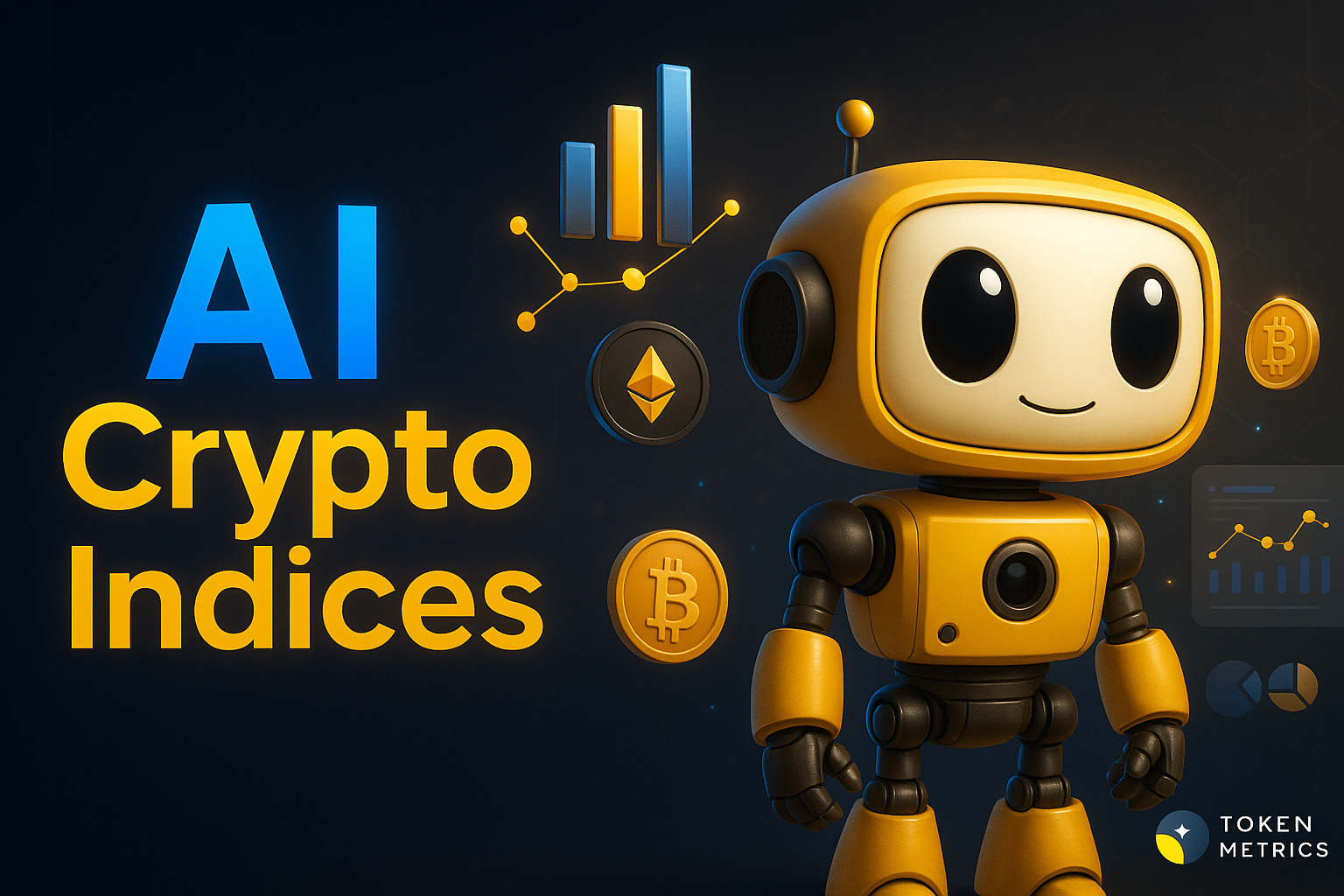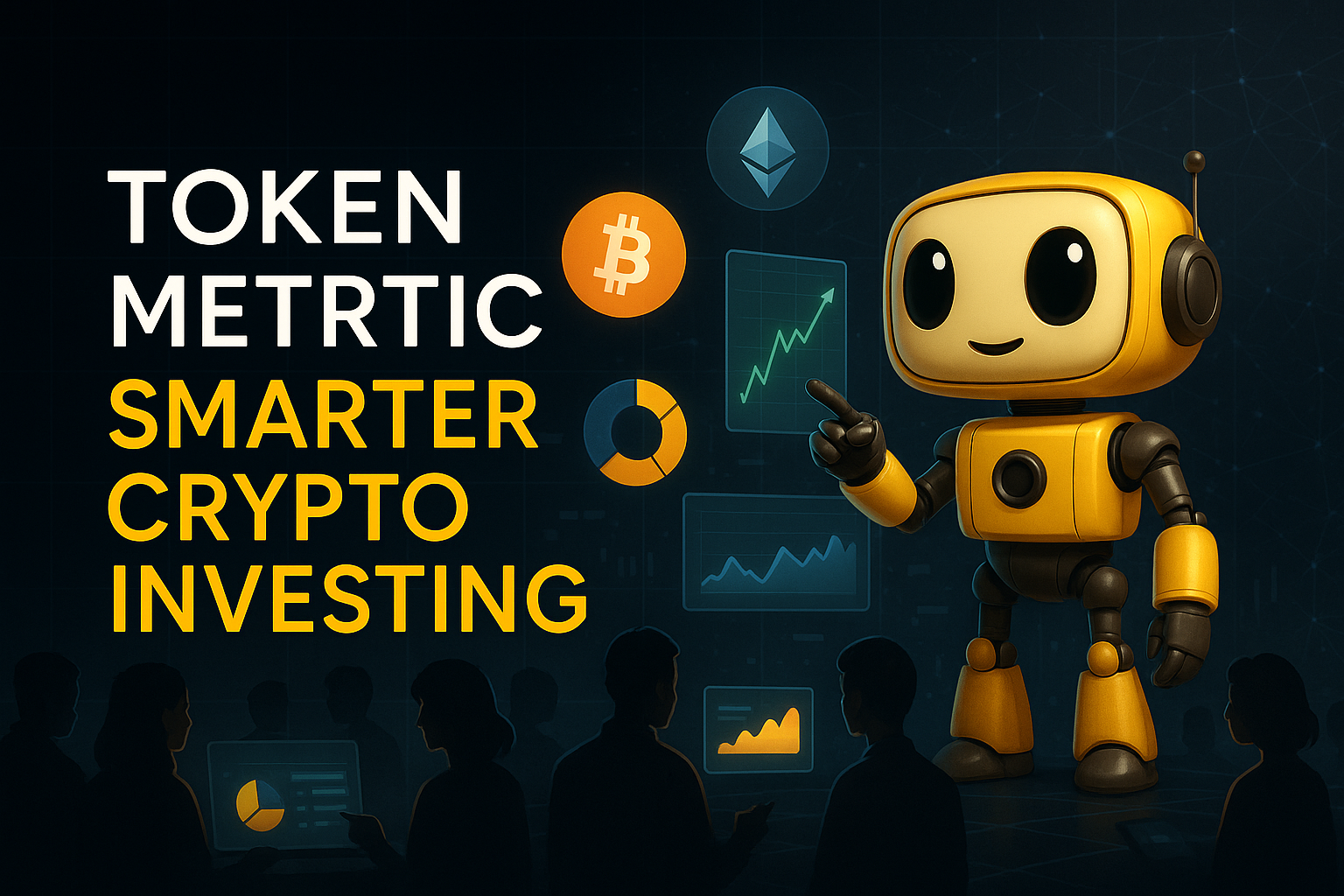The cryptocurrency market presents unprecedented wealth-building opportunities, but it also poses significant challenges.
With thousands of tokens competing for investor attention and market volatility that can erase gains overnight, success in crypto investing requires more than luck—it demands a strategic, data-driven approach.
Token Metrics AI Indices have emerged as a game-changing solution for investors seeking to capitalize on crypto's growth potential while managing risk effectively.
This comprehensive guide explores how to leverage these powerful tools to build, manage, and optimize your cryptocurrency portfolio for maximum returns in 2025 and beyond.
Understanding the AI Indices Investment Opportunity
The traditional approach to crypto investing involves countless hours of research, technical analysis, and constant market monitoring.
For most investors, this proves unsustainable.
Token Metrics solves this challenge by offering professionally managed, AI-driven index portfolios that automatically identify winning opportunities and rebalance based on real-time market conditions.
What makes Token Metrics indices unique is their foundation in machine learning technology.
The platform analyzes over 6,000 cryptocurrencies daily, processing more than 80 data points per asset including technical indicators, fundamental metrics, on-chain analytics, sentiment data, and exchange information.
This comprehensive evaluation far exceeds what individual investors can accomplish manually.
The indices employ sophisticated AI models including gradient boosting decision trees, recurrent neural networks, random forests, natural language processing algorithms, and anomaly detection frameworks.
These systems continuously learn from market patterns, adapt to changing conditions, and optimize portfolio allocations to maximize risk-adjusted returns.
Types of Token Metrics Indices: Finding Your Perfect Match
Token Metrics offers a diverse range of indices designed to serve different investment objectives, risk tolerances, and market outlooks.
Understanding these options is crucial for building an effective crypto portfolio.
Conservative Indices: Stability and Long-Term Growth
For investors prioritizing capital preservation and steady appreciation, conservative indices focus on established, fundamentally sound cryptocurrencies with proven track records.
These indices typically allocate heavily to Bitcoin and Ethereum while including select large-cap altcoins with strong fundamentals.
The Investor Grade Index exemplifies this approach, emphasizing projects with solid development teams, active communities, real-world adoption, and sustainable tokenomics.
This index is ideal for retirement accounts, long-term wealth building, and risk-averse investors seeking exposure to crypto without excessive volatility.
Balanced Indices: Growth with Measured Risk
Balanced indices strike a middle ground between stability and growth potential.
These portfolios combine major cryptocurrencies with promising mid-cap projects that demonstrate strong technical momentum and fundamental strength.
The platform's AI identifies tokens showing positive divergence across multiple indicators—rising trading volume, improving developer activity, growing social sentiment, and strengthening technical patterns.
Balanced indices typically rebalance weekly or bi-weekly, capturing emerging trends while maintaining core positions in established assets.
Aggressive Growth Indices: Maximum Upside Potential
For investors comfortable with higher volatility in pursuit of substantial returns, aggressive growth indices target smaller-cap tokens with explosive potential.
These portfolios leverage Token Metrics' Trader Grade system to identify assets with strong short-term momentum and technical breakout patterns.
Aggressive indices may include DeFi protocols gaining traction, Layer-1 blockchains with innovative technology, AI tokens benefiting from market narratives, and memecoins showing viral adoption patterns.
While risk is higher, the potential for 10x, 50x, or even 100x returns makes these indices attractive for portfolio allocation strategies that embrace calculated risk.
Sector-Specific Indices: Thematic Investing
Token Metrics offers specialized indices targeting specific cryptocurrency sectors, allowing investors to align portfolios with their market convictions and thematic beliefs.
• DeFi Index: Focuses on decentralized finance protocols including lending platforms, decentralized exchanges, yield aggregators, and synthetic asset platforms.
• Layer-1 Index: Concentrates on base-layer blockchains competing with Ethereum, including Solana, Avalanche, Cardano, Polkadot, and emerging ecosystems.
• AI and Machine Learning Index: Targets tokens at the intersection of artificial intelligence and blockchain technology.
• Memecoin Index: Contrary to traditional wisdom dismissing memecoins as purely speculative, Token Metrics recognizes that community-driven tokens can generate extraordinary returns.
This index uses AI to identify memecoins with genuine viral potential, active communities, and sustainable momentum before they become mainstream.
Building Your Token Metrics Index Portfolio: A Step-by-Step Framework
Success with Token Metrics indices requires more than simply choosing an index—it demands a comprehensive portfolio strategy tailored to your financial situation, goals, and risk tolerance.
Step 1: Assess Your Financial Profile
Begin by honestly evaluating your investment capacity, time horizon, and risk tolerance.
Ask yourself critical questions: How much capital can I allocate to crypto without compromising financial security? What is my investment timeline—months, years, or decades? How would I react emotionally to a 30% portfolio drawdown? What returns do I need to achieve my financial goals?
Your answers shape your portfolio construction.
Conservative investors with shorter timelines should emphasize stable indices, while younger investors with longer horizons can embrace more aggressive strategies.
Step 2: Determine Optimal Allocation Percentages
Financial advisors increasingly recommend including cryptocurrency in diversified portfolios, but the appropriate allocation varies significantly based on individual circumstances.
• Conservative Allocation (5-10% of portfolio): Suitable for investors approaching retirement or with low risk tolerance. Focus 80% on conservative indices, 15% on balanced indices, and 5% on sector-specific themes you understand deeply.
• Moderate Allocation (10-20% of portfolio): Appropriate for mid-career professionals building wealth. Allocate 50% to conservative indices, 30% to balanced indices, and 20% to aggressive growth or sector-specific indices.
• Aggressive Allocation (20-30%+ of portfolio): Reserved for younger investors with high risk tolerance and long time horizons. Consider 30% conservative indices for stability, 30% balanced indices for steady growth, and 40% split between aggressive growth and thematic sector indices.
Step 3: Implement Dollar-Cost Averaging
Rather than investing your entire allocation at once, implement a dollar-cost averaging strategy over 3-6 months.
This approach reduces timing risk and smooths out entry prices across market cycles.
For example, if allocating $10,000 to Token Metrics indices, invest $2,000 monthly over five months.
This strategy proves particularly valuable in volatile crypto markets where timing the perfect entry proves nearly impossible.
Step 4: Set Up Automated Rebalancing
Token Metrics indices automatically rebalance based on AI analysis, but you should also establish personal portfolio rebalancing rules.
Review your overall allocation quarterly and rebalance if any index deviates more than 10% from your target allocation.
If aggressive growth indices perform exceptionally well and grow from 20% to 35% of your crypto portfolio, take profits and rebalance back to your target allocation.
This disciplined approach ensures you systematically lock in gains and maintain appropriate risk levels.
Step 5: Monitor Performance and Adjust Strategy
While Token Metrics indices handle day-to-day portfolio management, you should conduct quarterly reviews assessing overall performance, comparing returns to benchmarks like Bitcoin and Ethereum, evaluating whether your risk tolerance has changed, and considering whether emerging market trends warrant allocation adjustments.
Use Token Metrics' comprehensive analytics to track performance metrics including total return, volatility, Sharpe ratio, maximum drawdown, and correlation to major cryptocurrencies.
These insights inform strategic decisions about continuing, increasing, or decreasing exposure to specific indices.
Advanced Strategies for Experienced Investors
Once comfortable with basic index investing, consider implementing advanced strategies to enhance returns and manage risk more effectively.
Tactical Overweighting
While maintaining core index allocations, temporarily overweight specific sectors experiencing favorable market conditions.
During periods of heightened interest in AI, increase allocation to the AI and Machine Learning Index by 5-10% at the expense of other sector indices.
Return to strategic allocation once the catalyst dissipates.
Combining Indices with Individual Tokens
Use Token Metrics indices for 70-80% of your crypto allocation while dedicating 20-30% to individual tokens identified through the platform's Moonshots feature.
This hybrid approach provides professional management while allowing you to pursue high-conviction opportunities.
Market Cycle Positioning
Adjust index allocations based on broader market cycles.
During bull markets, increase exposure to aggressive growth indices.
As conditions turn bearish, shift toward conservative indices with strong fundamentals.
Token Metrics' AI Indicator provides valuable signals for market positioning.
Risk Management: Protecting Your Capital
Even with sophisticated AI-driven indices, cryptocurrency investing carries substantial risks.
Implement robust risk management practices to protect your wealth.
Diversification Beyond Crypto
Never allocate so much to cryptocurrency that a market crash would devastate your financial position.
Most financial advisors recommend limiting crypto exposure to 5-30% of investment portfolios depending on age and risk tolerance.
Maintain substantial allocations to traditional assets—stocks, bonds, real estate—that provide diversification and stability.
Position Sizing and Security
Consider implementing portfolio-level stop-losses if your crypto allocation declines significantly from its peak.
Use hardware wallets or secure custody solutions for significant holdings.
Implement strong security practices including two-factor authentication and unique passwords.
Tax Optimization
Cryptocurrency taxation typically involves capital gains taxes on profits.
Consult tax professionals to optimize your strategy through tax-loss harvesting and strategic rebalancing timing.
Token Metrics' transaction tracking helps maintain accurate records for tax reporting.
Several factors distinguish Token Metrics indices from alternatives and explain their consistent outperformance.
Token Metrics indices respond to market changes in real-time rather than waiting for scheduled monthly or quarterly rebalancing.
This responsiveness proves crucial in crypto markets where opportunities can appear and disappear rapidly.
The platform's AI evaluates dozens of factors simultaneously—technical patterns, fundamental strength, on-chain metrics, sentiment analysis, and exchange dynamics.
This comprehensive approach identifies tokens that traditional indices would miss.
The AI continuously learns from outcomes, improving predictive accuracy over time.
Models that underperform receive reduced weighting while successful approaches gain influence, creating an evolving system that adapts to changing market dynamics.
Token Metrics' extensive coverage of 6,000+ tokens provides exposure to emerging projects before they gain mainstream attention, positioning investors for maximum appreciation potential.
Real-World Success: Making Token Metrics Indices Work for You
To illustrate practical application, consider several investor profiles and optimal index strategies.
Profile 1: Conservative 55-Year-Old Preparing for Retirement
Total portfolio: $500,000
Crypto allocation: $25,000 (5%)
Strategy: $20,000 in Investor Grade Index (80%), $4,000 in Balanced Index (16%), $1,000 in DeFi Index (4%)
This conservative approach provides crypto exposure with minimal volatility, focusing on established assets likely to appreciate steadily without risking retirement security.
Profile 2: Moderate 35-Year-Old Building Wealth
Total portfolio: $150,000
Crypto allocation: $30,000 (20%)
Strategy: $12,000 in Investor Grade Index (40%), $9,000 in Balanced Index (30%), $6,000 in Layer-1 Index (20%), $3,000 in Aggressive Growth Index (10%)
This balanced approach captures crypto growth potential while maintaining stability through substantial conservative and balanced allocations.
Profile 3: Aggressive 25-Year-Old Maximizing Returns
Total portfolio: $50,000
Crypto allocation: $15,000 (30%)
Strategy: $4,500 in Investor Grade Index (30%), $3,000 in Balanced Index (20%), $4,500 in Aggressive Growth Index (30%), $3,000 in Memecoin Index (20%)
This aggressive strategy embraces volatility and maximum growth potential, appropriate for younger investors with decades to recover from potential downturns.
Getting Started: Your Action Plan
Ready to begin building wealth with Token Metrics indices?
Follow this action plan:
• Week 1-2: Sign up for Token Metrics' 7-day free trial and explore available indices, historical performance, and educational resources. Define your investment goals, risk tolerance, and allocation strategy using the frameworks outlined in this guide.
• Week 3-4: Open necessary exchange accounts and wallets. Fund accounts and begin implementing your strategy through dollar-cost averaging. Set up tracking systems and calendar reminders for quarterly reviews.
• Ongoing: Follow Token Metrics' index recommendations, execute rebalancing transactions as suggested, monitor performance quarterly, and adjust strategy as your financial situation evolves.
Conclusion: The Future of Crypto Wealth Creation
Cryptocurrency represents one of the most significant wealth-building opportunities in modern financial history, but capturing this potential requires sophisticated approaches that most individual investors cannot implement alone.
Token Metrics AI Indices democratize access to professional-grade investment strategies, leveraging cutting-edge machine learning, comprehensive market analysis, and real-time responsiveness to build winning portfolios.
Whether you're a conservative investor seeking measured exposure or an aggressive trader pursuing maximum returns, Token Metrics provides indices tailored to your specific needs.
The choice between random coin picking and strategic, AI-driven index investing is clear.
One approach relies on luck and guesswork; the other harnesses data, technology, and proven methodologies to systematically build wealth while managing risk.
Your journey to crypto investment success begins with a single decision: commit to a professional, strategic approach rather than speculative gambling.
Token Metrics provides the tools, insights, and management to transform crypto investing from a game of chance into a calculated path toward financial freedom.
Start your 7-day free trial today and discover how AI-powered indices can accelerate your wealth-building journey.
The future of finance is decentralized, intelligent, and accessible—make sure you're positioned to benefit.
Why Choose Token Metrics for AI-Powered Crypto Indices?
Token Metrics stands out as a leader in AI-driven crypto index solutions.
With over 6,000 tokens analyzed daily and indices tailored to every risk profile, the platform provides unparalleled analytics, real-time rebalancing, and comprehensive investor education.
Its commitment to innovation and transparency makes it a trusted partner for building your crypto investment strategy in today's fast-evolving landscape.
FAQ: How do Token Metrics indices work?
Token Metrics indices use advanced AI models to analyze technical, fundamental, on-chain, and sentiment data across thousands of cryptocurrencies.
They construct balanced portfolios that are automatically rebalanced in real-time to adapt to evolving market conditions and trends.
FAQ: What types of indices are available?
There are conservative, balanced, aggressive growth, and sector-specific indices including DeFi, Layer-1, AI, and memecoins.
Each index is designed for a different investment objective, risk tolerance, and market outlook.
FAQ: Is there a minimum investment required?
No mandatory minimum is outlined for using Token Metrics indices recommendations.
You can adapt your allocation based on your personal investment strategy, capacity, and goals.
FAQ: How often should I rebalance my portfolio?
Token Metrics indices are rebalanced automatically based on dynamic AI analysis, but it is recommended to review your overall crypto allocation at least quarterly to ensure alignment with your targets.
FAQ: Are Token Metrics indices secure?
Token Metrics provides analytics and index recommendations; investors maintain custody of their funds and should implement robust security practices such as hardware wallets and two-factor authentication.
FAQ: Does using Token Metrics indices guarantee profits?
No investing approach, including AI-driven indices, can guarantee profits.
The goal is to maximize risk-adjusted returns through advanced analytics and professional portfolio management, but losses remain possible due to the volatile nature of crypto markets.
Disclaimer
This article is for educational and informational purposes only.
It does not constitute financial, investment, or tax advice.
Cryptocurrency investing carries risk, and past performance does not guarantee future results. Always consult your own advisor before making investment decisions.



.svg)


.png)




%201.svg)
%201.svg)


%201.svg)









.svg)




.png)